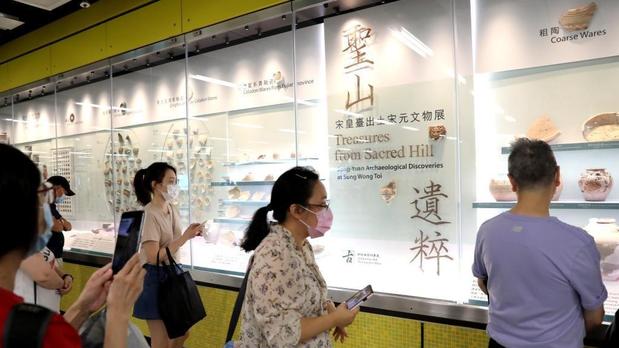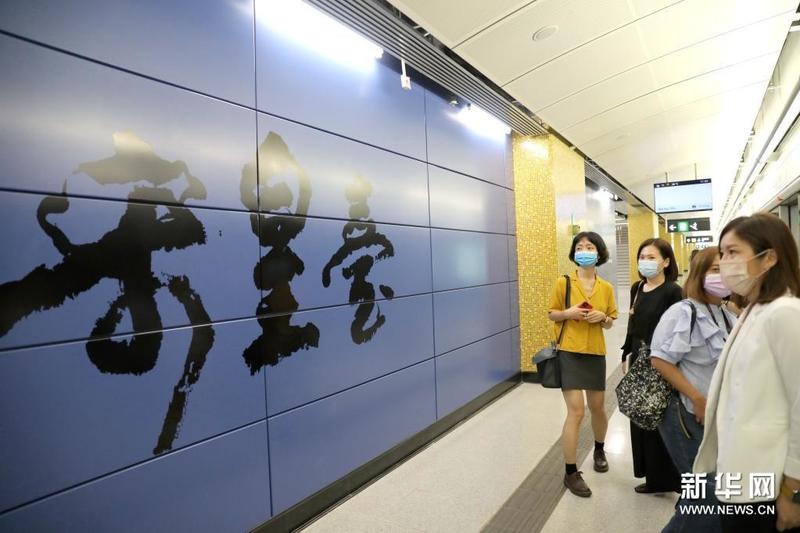 Visitors look numerous relics from the exhibition named Treasures from Sacred Hill at Sung Wong Toi Station, Hong Kong on July 6, 2021. (PHOTO / XINHUA)
Visitors look numerous relics from the exhibition named Treasures from Sacred Hill at Sung Wong Toi Station, Hong Kong on July 6, 2021. (PHOTO / XINHUA)
HONG KONG - Hundreds of railway fans rushed into the entrance of Sung Wong Toi Station located in Kowloon City District at around 5:00 am local time on June 27 to get on the first ride on the opening day of Hong Kong's long-waited Tuen Ma Line.
For the residents living in the centuries-old area, the newly-opened MTR station has been added to their collective memories imprinted by Hong Kong's former Kai Tak Airport and the now-demolished Kowloon Walled City.
Hong Kong's public transit railway system, as a sign of speed and modernity, has surfaced itself with an exhibition of archaeological finds along with Chinese calligraphy in brush and ink.
The exhibition named Treasures from Sacred Hill at Sung Wong Toi Station, Hong Kong's first exhibition at a subway station, displays numerous relics including ceramic vases, incense burners and even pottery dice excavated during the station's construction.
"The findings are so rare. It has been the first time in Hong Kong with archaeological items with such a scale," Ray Ma, curator of Archaeology at Hong Kong's Antiquities and Monument Office, told Xinhua, adding that the findings can unveil the picture of Kowloon City and Hong Kong from thousands of years ago.
The exhibition welcomes an average of about 6,000 to 8,000 visitors per day, according to the Antiquities and Monument Office under the Hong Kong Special Administrative Region government's Development Bureau.
The exhibition named Treasures from Sacred Hill at Sung Wong Toi Station, Hong Kong's first exhibition at a subway station, displays numerous relics including ceramic vases, incense burners and even pottery dice excavated during the station's construction
ALSO READ: Tuen Ma Line Phase 1 to open on Feb 14
Susanna Siu, executive secretary at the Antiquities and Monument Office, said the exhibition is about "introducing people the history at an accessible place in a way that can interest them."
Historical literature says one young emperor, in the final years of China's Southern Song dynasty, stayed at the current Kowloon City for a few months while fleeing the Mongol onslaught. The name "Sung Wong," meaning Song emperor in Chinese, is thus coined in the name of the station.
The archaeological finds in Hong Kong have been derived from the same origin as that of the Chinese mainland, though the place was not at the center stage in China's ancient history, Ma said.
While a significant amount of relics unearthed from China's Song and Yuan dynasties, the name of Sung Wong Toi Station is written in running scripts known as "Xingshu" by MTR's retired architect Abe Au Kit Tong to echo the calligraphy style that was popular during the Song dynasty.
"Chinese calligraphy has become a signature for Hong Kong's subway platforms," Au, 71, who is now teaching Chinese calligraphy in Canada after retirement, told Xinhua via a video interview.
His Chinese ink-and-brush writing featuring strong visual effects, along with the mosaic tiles in distinctive colors, was applied since the opening of the Hong Kong Island Line in the 1980s to help passengers distinguish different stations.
Chinese calligraphy, like architecture, is also about drawing lines and achieving balance by the exact ratio of different parts, Au said, while his displayed works at stations are more about finding the rhythm that suits the characteristics of each station.
The newly opened Tuen Ma Line, where Au's artworks are showcased, is Hong Kong's longest railway line that stretches 56 km with 27 stations.
Putting aside the challenging task of protecting historical sites during construction, building stations is hard in Hong Kong's well-developed and densely-populated communities, Senior Architectural Manager of Tuen Ma Line Wincy Chow said.
The construction needs to be carried out without obstructing transportation on the ground and plans were adjusted for the five ancient wells found at the site, according to Chow.
MTR, the public transit system that transports millions of passengers during normal weekdays, is not only a carrier but also a messenger from the past to the future.
"With the development of the economy, people's voice for historic monuments conservation is growing louder," Commissioner for Heritage Ivanhoe Chang said, and the Antiquities and Monument Office was founded in 1976 to protect and preserve Hong Kong's historic treasures.
However, challenges remain in today's rapid modernization process.
"About 30 years ago, there was no Chinese calligraphy class taught in my son's middle school," MTR's calligrapher Au recalled.
The number of people practicing this traditional art in Hong Kong has been decreasing, he said, and his calligraphy works with distinguishing styles inherited from different dynasties were sometimes taken as wrongly written characters. "Chinese calligraphy and printing characters are not the same thing," he said.
 Visitors look the name of Sung Wong Toi Station in Chinese calligraphy style, Hong Kong on July 6, 2021. (PHOTO / XINHUA)
Visitors look the name of Sung Wong Toi Station in Chinese calligraphy style, Hong Kong on July 6, 2021. (PHOTO / XINHUA)
READ MORE: HK transport chief: Tuen Ma Line to fully open on June 27
"I hope my works, if possible, can remind people of such a thing called Chinese calligraphy," Au said.
In Hong Kong's Tsim Sha Tsui area, the Former Kowloon-Canton Railway Clock Tower, standing beside the Victoria Harbor, used to be an iconic landmark and a key link between Hong Kong and mainland cities including Guangzhou and Beijing during the old days. The modern high-speed rail at West Kowloon came into operation in 2018.
"Demolition and redevelopment happen all the time," Chang said. "By taking account of history while looking into the future, we need to strike a prominent balance between development and conservation in order to achieve sustainable development."


